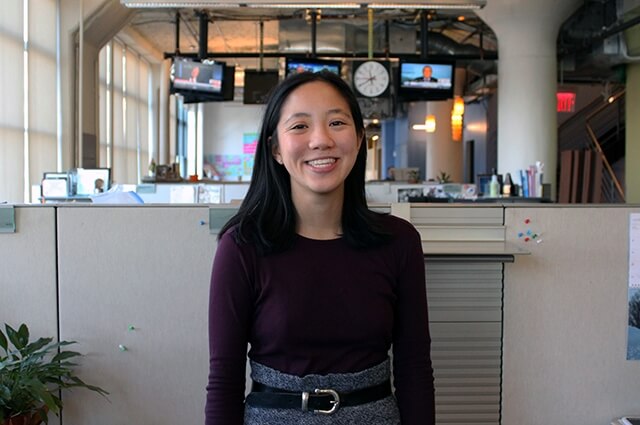Growing up in New York City’s Chinatown, Jenny Ye watched as her neighbors, longtime Chinese-speaking residents, were evicted by landlords seeking higher rents from an influx of affluent young professionals.
Not satisfied to watch her neighborhood change before her eyes, Ye applied the lessons she was learning as a volunteer with a local tenant organizing group to come to their aid.
“I was meeting with tenants who didn’t have hot water or heat because their landlords were trying to get them to leave,” she recalled. “I learned everything I could about tenant’s rights, and then used my Chinese language skills to interpret and transfer that information to my neighbors.”
Those experiences spawned Ye’s interest in government. At Harvard, the freshman immediately got involved with the Institute of Politics at the Harvard Kennedy School, attending lectures and volunteering to teach civics to local fifth graders.
Though she remained passionate about politics, her academic plans shifted after she took Introduction to Computer Science (CS50). Ye saw how she could use technology to empower others, from mistreated tenants to marginalized voters, so she concentrated in computer science at the John A. Paulson School of Engineering and Applied Sciences.
During an IOP study group, she met an editor at WNYC who was starting a data journalism team. Intrigued by the concept of helping journalists analyze large data sets, Ye interned with the team after her junior year. She quickly developed an affinity for reporting and joined full-time after graduation.
“It was a good mix of working with reporters across the newsroom and coming up with stories on my own or as part of a team,” said Ye, A.B. ’13. “I enjoyed building data tools I could share, and also learning more about New York City, which is so fascinating and multi-faceted.”
Among her proudest achievements is a story covering a 2016 voter purge. With a presidential primary approaching in April, Ye noticed that the number of registered voters in Brooklyn had declined over the past six months, while almost every other county saw an increase during the same period.
The Board of Elections said it was a routine removal of people who had moved or passed away. By analyzing voter roll data, she helped determine that more than 100,000 names had been removed, and those with Hispanic or Asian last names were disproportionately affected by the purge.
Ye used the data to develop maps and charts that conveyed the bigger picture of which Brooklyn neighborhoods were most heavily affected.
The Board of Elections eventually admitted that all purged voters had been removed by mistake, but the records weren’t added back into the system in time for the primary, Ye said.
“What started as an election story turned into an investigation of the Board of Elections and an analysis of the checks that are in place to prevent something like this from happening again,” she said. “Using our reporting, several advocacy groups ended up suing the Board of Elections, which led to federal monitoring being put in place for subsequent elections in New York City.”
Ye felt gratified by the impact of her work, and enjoyed tackling new challenges with each complex story. Often, the data she needed was trapped in PDFs and required considerable cleaning and organizing to make it machine-readable.
Other times, the data didn’t exist at all. For instance, when the New York City Department of Education refused to share locations of high schools that have metal detectors, Ye and her colleagues were forced to call or visit each high school to find out for themselves.
“We often had to get creative about how we would figure out the big picture of the story,” she said.
Ye has taken that creativity to a new level at Quartz, which she joined last spring. Working for the news site’s new Bot Studio, she is developing conversational chat bots for Facebook messenger and WhatsApp that help journalists.
A recent project, Electionland, was utilized during last year’s mid-term elections. The chat bots helped voters report issues at their polling places in real time so journalists could quickly investigate, Ye said.
She created channels so incoming tips were organized in an accessible location, enabling reporters from across the country to see tips from their coverage areas. The biggest challenge was anticipating when users would go off-script, and ensuring the AI tool was able to keep the conversation going and get them back on track, she said.
“There are so many projects or stories where an enormous amount of data exists, either in text form, photos, or videos, that reporters could really use some help in finding patterns or looking for certain information,” she said. “That’s when machine learning could really come in handy to cut down the time it takes to find, with some degree of certainty, what someone is looking for.”
For instance, she and her colleagues are currently studying whether they can build models to generate tips for reporters. It is one of several projects they are exploring through the Quartz AI Studio, an effort to help journalists use machine learning in their reporting.
She works in a fast-paced world, with constant deadlines and pressure to reach readers who are increasingly skeptical. But Ye enjoys being involved with such a supportive community of journalists.
She feels grateful to use her skills to make a real impact in the world, from Manhattan’s Chinatown to the halls of Congress.
“There is only going to be more data available online in the future. It is going to be increasingly important to be able to find, through the noise, what is actually useful and what is news,” she said. “These public institutions impact our reader’s daily lives. I want to be holding them accountable, and there’s a lot of ways that machine-learning can help us do that.”
Press Contact
Adam Zewe | 617-496-5878 | azewe@seas.harvard.edu
